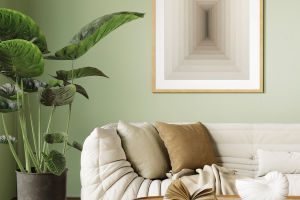Minimalist design is more than just a trend; it's a lifestyle choice that helps us focus on what truly matters by removing distractions. If we're looking to transform our living space into a peaceful retreat, adopting a minimalist approach in the living room is an excellent starting point.
In this article, we'll explore five simple but powerful ideas to help us create a serene, functional, and stylish minimalist living room that feels both inviting and calming.
1. Choose a Neutral Color Palette
One of the foundational principles of minimalist design is using a neutral color palette. By opting for soft shades of white, beige, grey, and muted tones, we create a sense of openness and tranquility in our living space. These colors not only reflect light but also provide a calming backdrop that enhances the room's simplicity. To add warmth and texture, we can incorporate natural materials like wood or stone in subtle accents such as a coffee table or a small shelf. A neutral color palette gives us the freedom to play with design elements without overwhelming the senses.
2. Focus on Functional Furniture
In a minimalist living room, less is more when it comes to furniture. Instead of filling the space with numerous pieces, we should focus on selecting functional, high-quality furniture that serves a purpose while maintaining clean lines. Choose a comfortable sofa that doesn't take up too much space, a simple coffee table, and a few storage solutions that help keep clutter at bay. It's important to select items that provide utility without overcrowding the room. Think about multi-functional furniture that can serve more than one purpose, such as a sofa that doubles as a bed or a coffee table with hidden storage.
3. Prioritize Open Space
Open space is crucial to achieving a minimalist aesthetic. To create a serene environment, we need to be mindful of the layout and avoid overcrowding the room with excessive furniture or decorations. Instead, we can leave ample open space between the furniture pieces to allow the room to breathe and feel more expansive. By removing unnecessary items, we can create an open, uncluttered atmosphere that promotes relaxation and peace. The more space we have, the more the room feels inviting and less chaotic.
4. Keep Decorations Simple
When it comes to decorations in a minimalist living room, less is definitely more. Instead of filling the room with trinkets or too many accessories, we should choose a few thoughtfully selected pieces that add character and personality to the space. A single statement artwork, a small potted plant, or a decorative vase can make a significant impact without overwhelming the room. By keeping our decorations simple, we allow the beauty of the space itself to shine through, creating a balanced and harmonious environment.
5. Embrace Natural Light
Natural light is essential in any minimalist living room. It not only helps illuminate the space but also creates a connection to the outdoors, which contributes to a sense of calm and well-being. To maximize natural light, we can opt for light, airy curtains or blinds that allow sunlight to flow into the room. If possible, we can arrange furniture near windows to make the most of the daylight. The more natural light we have, the more spacious and peaceful the room will feel.
Conclusion: Less is More
Adopting a minimalist approach to our living room design can completely transform our space into a peaceful sanctuary. By choosing neutral colors, focusing on functional furniture, prioritizing open space, keeping decorations simple, and embracing natural light, we create a serene and inviting environment that helps us unwind and find clarity in our busy lives. Minimalism isn't just about reducing the amount of stuff we have—it's about creating a space that supports our well-being and enhances our lifestyle. Let's embrace the beauty of simplicity and enjoy the tranquility it brings.


